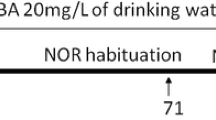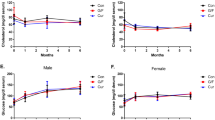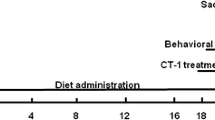Abstract
Accumulated evidence indicates that neuroinflammation induces insulin resistance in the brain. Moreover, both processes are intimately linked to neurodegenerative disorders, including Alzheimer’s disease. Potential mechanisms underlying insulin resistance include serine phosphorylation of the insulin receptor substrate (IRS) or insulin receptor (IR) misallocation. However, only a few studies have focused on IRS expression in the brain and its modulation in neuroinflammatory processes. This study used the high-fat diet (HFD) model of neuroinflammation to study the alterations of IR, an insulin-like growth factor receptor (IGF1R) and IRS expressions in the hippocampus. We observed that HFD effectively reduced mRNA and protein IRS2 expression. In contrast, a HFD induced the upregulation of the IRS1 mRNA levels, but did not alter an IR and IGF1R expression. As expected, we observed that a HFD increased hippocampal tumor necrosis factor alpha (TNFα) and amyloid precursor protein (APP) levels while reducing brain-derived neurotrophic factor (BDNF) expression and neurogenesis. Interestingly, we found that TNFα correlated positively with IRS1 and negatively with IRS2, whereas APP levels correlated positively only with IRS1 but not IRS2. These results indicate that IRS1 and IRS2 hippocampal expression can be affected differently by HFD-induced neuroinflammation. In addition, we aimed to establish whether abscisic acid (ABA) can rescue hippocampal IRS1 and IRS2 expression, as we had previously shown that ABA supplementation prevents memory impairments and improves neuroinflammation induced by a HFD. In this study, ABA restored HFD-induced hippocampal alterations, including IRS1 and IRS2 expression, TNFα, APP, and BDNF levels and neurogenesis. In conclusion, this study highlights different regulations of hippocampal IRS1 and IRS2 expression using a HFD, indicating the important differences of these scaffolding proteins, and strongly supports ABA therapeutic effects.




Similar content being viewed by others
Change history
26 February 2019
The author missed to include the second affiliation of Mariam Atef to the original paper published. With this, the authors published this correction.
Abbreviations
- ABA:
-
Abscisic acid
- ANOVA:
-
Analysis of variance
- APP:
-
Amyloid precursor protein
- BDNF:
-
Brain-derived neurotrophic factor
- ERK:
-
Extracellular regulated kinases
- HFD:
-
High-fat diet
- IGF1:
-
Insulin-like growth factor
- IGF1R:
-
Insulin-like growth factor receptor
- IR:
-
Insulin receptor
- IRS:
-
Insulin receptor substrate
- PFA:
-
Paraformaldehyde
- PPAR-γ:
-
Peroxisome proliferator-activated receptor gamma
- RTqPCR:
-
Real-time quantitative polymerase chain reaction
- SEM:
-
Standard error of mean
- SD:
-
Standard diet
- SGZ:
-
Subgranular zone
- TBS:
-
Tris-buffered saline
- TDZ:
-
Thiazolidinediones
- TNFα:
-
Tumor necrosis factor alpha
References
Lazarov O, Hollands C (2016) Hippocampal neurogenesis: Learning to remember. Prog Neurobiol 138–140:1–18. https://doi.org/10.1016/j.pneurobio.2015.12.006
Lang BT, Yan Y, Dempsey RJ, Vemuganti R (2009) Impaired neurogenesis in adult type-2 diabetic rats. Brain Res 1258:25–33. https://doi.org/10.1016/j.brainres.2008.12.026
Ryan SM, Nolan YM (2016) Neuroinflammation negatively affects adult hippocampal neurogenesis and cognition: can exercise compensate? Neurosci Biobehav Rev 61:121–131. https://doi.org/10.1016/j.neubiorev.2015.12.004
Ramirez S, Liu X, Lin P-A, Suh J, Pignatelli M, Redondo RL, Ryan TJ, Tonegawa S (2013) Creating a false memory in the hippocampus. Science 341:387–391
O’Leary OF, Cryan JF (2014) A ventral view on antidepressant action: roles for adult hippocampal neurogenesis along the dorsoventral axis. Trends Pharmacol Sci 35:675–687. https://doi.org/10.1016/j.tips.2014.09.011
Stephenson J, Nutma E, van der Valk P, Amor S (2018) Inflammation in CNS neurodegenerative diseases. Immunology. https://doi.org/10.1111/imm.12922
Breitner JC (1996) The role of anti-inflammatory drugs in the prevention and treatment of Alzheimer’s disease. Annu Rev Med 47:401–411. https://doi.org/10.1146/annurev.med.47.1.401
Eikelenboom P, Bate C, Van Gool WA et al (2002) Neuroinflammation in Alzheimer’s disease and prion disease. Glia 40:232–239. https://doi.org/10.1002/glia.10146
Eikelenboom P, Veerhuis R, Scheper W, Rozemuller AJM, van Gool WA, Hoozemans JJM (2006) The significance of neuroinflammation in understanding Alzheimer’s disease. J Neural Transm 113:1685–1695. https://doi.org/10.1007/s00702-006-0575-6
Heneka MT, Carson MJ, El KJ et al (2015) Neuroinflammation in Alzheimer’s disease. Lancet Neurol 14:388–405. https://doi.org/10.1016/S1474-4422(15)70016-5
Yuan M, Konstantopoulos N, Lee J, Hansen L, Li ZW, Karin M, Shoelson SE (2001) Reversal of obesity- and diet-induced insulin resistance with salicylates or targeted disruption of Ikkbeta. Science 293:1673–1677. https://doi.org/10.1126/science.1061620
Gao Z, Hwang D, Bataille F, Lefevre M, York D, Quon MJ, Ye J (2002) Serine phosphorylation of insulin receptor substrate 1 by inhibitor B kinase complex. J Biol Chem 277:48115–48121. https://doi.org/10.1074/jbc.M209459200
de la Monte SM (2017) Insulin resistance and neurodegeneration: progress towards the development of new therapeutics for Alzheimer’s disease. Drugs 77:47–65. https://doi.org/10.1007/s40265-016-0674-0
Wang D, Yan J, Chen J, Wu W, Zhu X, Wang Y (2015) Naringin improves neuronal insulin signaling, brain mitochondrial function, and cognitive function in high-fat diet-induced obese mice. Cell Mol Neurobiol 35:1061–1071. https://doi.org/10.1007/s10571-015-0201-y
Pipatpiboon N, Pratchayasakul W, Chattipakorn N, Chattipakorn SC (2012) PPAR agonist improves neuronal insulin receptor function in hippocampus and brain mitochondria function in rats with insulin resistance induced by long term high-fat diets. Endocrinology 153:329–338. https://doi.org/10.1210/en.2011-1502
Sun X, Yao H, Douglas RM, Gu XQ, Wang J, Haddad GG (2010) Insulin/PI3K signaling protects dentate neurons from oxygen–glucose deprivation in organotypic slice cultures. J Neurochem 112:377–388. https://doi.org/10.1111/j.1471-4159.2009.06450.x
Gage FH, van Praag H, Kempermann G (1999) Running increases cell proliferation and neurogenesis in the adult mousedentate gyrus. Nat Neurosci 2:266–270. https://doi.org/10.1038/6368
Vivar C, Potter MC, van Praag H (2013) All about running: synaptic plasticity, growth factors and adult hippocampal neurogenesis. Curr Top Behav Neurosci 15:189–210. https://doi.org/10.1007/7854_2012_220
Timinkul A, Kato M, Omori T, Deocaris CC, Ito A, Kizuka T, Sakairi Y, Nishijima T et al (2008) Enhancing effect of cerebral blood volume by mild exercise in healthy young men: a near-infrared spectroscopy study. Neurosci Res 61:242–248. https://doi.org/10.1016/j.neures.2008.03.012
Nishijima T, Piriz J, Duflot S, Fernandez AM, Gaitan G, Gomez-Pinedo U, Verdugo JMG, Leroy F et al (2010) Neuronal activity drives localized blood-brain-barrier transport of serum insulin-like growth factor-I into the CNS. Neuron 67:834–846. https://doi.org/10.1016/j.neuron.2010.08.007
Choi Y-S, Cho H-Y, Hoyt KR, Naegele JR, Obrietan K (2008) IGF-1 receptor-mediated ERK/MAPK signaling couples status epilepticus to progenitor cell proliferation in the subgranular layer of the dentate gyrus. Glia 56:791–800. https://doi.org/10.1002/glia.20653
Wei Z, Liao J, Qi F, Meng Z, Pan S (2015) Evidence for the contribution of BDNF-TrkB signal strength in neurogenesis: an organotypic study. Neurosci Lett 606:48–52. https://doi.org/10.1016/j.neulet.2015.08.032
Wrann CD, White JP, Salogiannnis J, Laznik-Bogoslavski D, Wu J, Ma D, Lin JD, Greenberg ME et al (2013) Exercise induces hippocampal BDNF through a PGC-1α/FNDC5 pathway. Cell Metab 18:649–659. https://doi.org/10.1016/j.cmet.2013.09.008
Ding Q, Vaynman S, Akhavan M, Ying Z, Gomez-Pinilla F (2006) Insulin-like growth factor I interfaces with brain-derived neurotrophic factor-mediated synaptic plasticity to modulate aspects of exercise-induced cognitive function. Neuroscience 140:823–833. https://doi.org/10.1016/j.neuroscience.2006.02.084
Bedse G, Di Domenico F, Serviddio G, Cassano T (2015) Aberrant insulin signaling in Alzheimer’s disease: current knowledge. Front Neurosci 9:1–13. https://doi.org/10.3389/fnins.2015.00204
Wilcox G (2005) Insulin and insulin resistance. The Clinical biochemist Reviews/Australian Association of Clinical Biochemists 26:19–39. https://doi.org/10.1016/S0025-7125(03)00128-7
Duarte AI, Moreira PI, Oliveira CR (2012) Insulin in central nervous system: more than just a peripheral hormone. Journal of Aging Research 2012:1–21. https://doi.org/10.1155/2012/384017
Zemva J, Udelhoven M, Moll L et al (2013) Neuronal overexpression of insulin receptor substrate 2 leads to increased fat mass, insulin resistance, and glucose intolerance during aging. Age (Dordrech, Neth) 35:1881–1897. https://doi.org/10.1007/s11357-012-9491-x
Moloney AM, Griffin RJ, Timmons S, O’Connor R, Ravid R, O’Neill C (2010) Defects in IGF-1 receptor, insulin receptor and IRS-1/2 in Alzheimer’s disease indicate possible resistance to IGF-1 and insulin signalling. Neurobiol Aging 31:224–243. https://doi.org/10.1016/j.neurobiolaging.2008.04.002
Zhao W, Chen H, Xu H, Moore E, Meiri N, Quon MJ, Alkon DL (1999) Brain insulin receptors and spatial memory. Correlated changes in gene expression, tyrosine phosphorylation, and signaling molecules in the hippocampus of water maze trained rats. J Biol Chem 274:34893–34902. https://doi.org/10.1074/JBC.274.49.34893
Mir S, Cai W, Carlson SW, Saatman KE, Andres DA (2017) IGF-1 mediated neurogenesis involves a novel RIT1/Akt/Sox2 Cascade. Sci Rep 7:3283. https://doi.org/10.1038/s41598-017-03641-9
Nieto-Estévez V, Defterali Ç, Vicario-Abejón C (2016) IGF-I: a key growth factor that regulates neurogenesis and synaptogenesis from embryonic to adult stages of the brain. Front Neurosci 10:52. https://doi.org/10.3389/fnins.2016.00052
Marks JL, Porte D, Stahl WL, Baskin DG (1990) Localization of insulin receptor mRNA in rat brain by in situ hybridization. Endocrinology 127:3234–3236. https://doi.org/10.1210/endo-127-6-3234
Schmitz-Peiffer C (2000) Signalling aspects of insulin resistance in skeletal muscle: mechanisms induced by lipid oversupply. Cell Signal 12:583–594
Sesti G, Federici M, Hribal ML et al (2001) Defects of the insulin receptor substrate (IRS) system in human metabolic disorders. FASEB J 15:2099–2111. https://doi.org/10.1096/fj.01-0009rev
Pederson TM, Kramer DL, Rondinone CM (2001) Serine/threonine phosphorylation of IRS-1 triggers its degradation: possible regulation by tyrosine phosphorylation. Diabetes 50:24–31
Potashnik R, Bloch-Damti A, Bashan N, Rudich A (2003) IRS1 degradation and increased serine phosphorylation cannot predict the degree of metabolic insulin resistance induced by oxidative stress. Diabetologia 46:639–648. https://doi.org/10.1007/s00125-003-1097-5
Cardoso S, Santos R, Correia S, Carvalho C, Zhu X, Lee HG, Casadesus G, Smith M et al (2009) Insulin and insulin-sensitizing drugs in neurodegeneration: mitochondria as therapeutic targets. Pharmaceuticals 2:250–286. https://doi.org/10.3390/ph2030250
Bassaganya-Riera J, Guri AJ, Lu P, Climent M, Carbo A, Sobral BW, Horne WT, Lewis SN et al (2011) Abscisic acid regulates inflammation via ligand-binding domain-independent activation of peroxisome proliferator-activated receptor gamma. J Biol Chem 286:2504–2516. https://doi.org/10.1074/jbc.M110.160077
Sánchez-Sarasúa S, Moustafa S, García-Avilés Á, López-Climent MF, Gómez-Cadenas A, Olucha-Bordonau FE, Sánchez-Pérez AM (2016) The effect of abscisic acid chronic treatment on neuroinflammatory markers and memory in a rat model of high-fat diet induced neuroinflammation. Nutr Metab 13:73. https://doi.org/10.1186/s12986-016-0137-3
Magnone M, Ameri P, Salis A, Andraghetti G, Emionite L, Murialdo G, de Flora A, Zocchi E (2015) Microgram amounts of abscisic acid in fruit extracts improve glucose tolerance and reduce insulinemia in rats and in humans. FASEB J 29:4783–4793. https://doi.org/10.1096/fj.15-277731
Qi CC, Ge JF, Zhou JN (2015) Preliminary evidence that abscisic acid improves spatial memory in rats. Physiol Behav 139:231–239. https://doi.org/10.1016/j.physbeh.2014.11.053
Lu P, Hontecillas R, Horne WT, Carbo A, Viladomiu M, Pedragosa M, Bevan DR, Lewis SN et al (2012) Computational modeling-based discovery of novel classes of anti-inflammatory drugs that target lanthionine synthetase C-like protein 2. PLoS One 7:e34643. https://doi.org/10.1371/journal.pone.0034643
Lu P, Hontecillas R, Philipson CW, Bassaganya-Riera J (2014) Lanthionine synthetase component C-like protein 2: a new drug target for inflammatory diseases and diabetes. Curr Drug Targets 15:565–572
Paxinos G, Watson C (2013) The rat brain in stereotaxic coordinates: hard cover edition. Elsevier Science
Pearson K (1895) Note on regression and inheritance in the case of two parents. Proc R Soc Lond (1854–1905) 58:240–242. https://doi.org/10.1098/rspl.1895.0041
Stigler SM (1989) Francis Galton’s account of the invention of correlation. Stat Sci 4:73–79. https://doi.org/10.1214/ss/1177012580
Galton F (1886) Regression towards mediocrity in hereditary stature. 15:246–263
Cohen J (1988) Statistical power analysis for the behavioral sciences, 2nd edn. L. Erlbaum Associates, Hillsdale
Elmarakby AA, Imig JD (2010) Obesity is the major contributor to vascular dysfunction and inflammation in high-fat diet hypertensive rats. Clin Sci 118:291–301. https://doi.org/10.1042/CS20090395
Bhat NR, Thirumangalakudi L (2013) Increased tau phosphorylation and impaired brain insulin/IGF signaling in mice fed a high fat/high cholesterol diet. Journal of Alzheimer’s disease: JAD 36:781–789. https://doi.org/10.3233/JAD-2012-121030
Korzhevskii DE, Karpenko MN, Kirik OV (2012) Microtubule-associated proteins as indicators of differentiation and the functional state of nerve cells. Neurosci Behav Physiol 42:215–222. https://doi.org/10.1007/s11055-012-9556-4
Petrov D, Pedrós I, Artiach G, Sureda FX, Barroso E, Pallàs M, Casadesús G, Beas-Zarate C et al (2015) High-fat diet-induced deregulation of hippocampal insulin signaling and mitochondrial homeostasis deficiences contribute to Alzheimer disease pathology in rodents. Biochim Biophys Acta (BBA) - Mol Basis Dis 1852:1687–1699. https://doi.org/10.1016/j.bbadis.2015.05.004
Liu Z, Patil IY, Jiang T, Sancheti H, Walsh JP, Stiles BL, Yin F, Cadenas E (2015) High-fat diet induces hepatic insulin resistance and impairment of synaptic plasticity. PLoS One 10:e0128274. https://doi.org/10.1371/journal.pone.0128274
Alfaro FJ, Gavrieli A, Saade-Lemus P, Lioutas VA, Upadhyay J, Novak V (2018) White matter microstructure and cognitive decline in metabolic syndrome: a review of diffusion tensor imaging. Metabolism 78:52–68. https://doi.org/10.1016/j.metabol.2017.08.009
Stump M, Mukohda M, Hu C, Sigmund CD (2015) PPARγ regulation in hypertension and metabolic syndrome. Curr Hypertens Rep 17:89. https://doi.org/10.1007/s11906-015-0601-x
Guri AJ, Hontecillas R, Ferrer G, Casagran O, Wankhade U, Noble AM, Eizirik DL, Ortis F et al (2008) Loss of PPARγ in immune cells impairs the ability of abscisic acid to improve insulin sensitivity by suppressing monocyte chemoattractant protein-1 expression and macrophage infiltration into white adipose tissue. J Nutr Biochem 19:216–228. https://doi.org/10.1016/j.jnutbio.2007.02.010
Ullah F, Liang A, Rangel A, Gyengesi E, Niedermayer G, Münch G (2017) High bioavailability curcumin: an anti-inflammatory and neurosupportive bioactive nutrient for neurodegenerative diseases characterized by chronic neuroinflammation. Arch Toxicol 91:1623–1634. https://doi.org/10.1007/s00204-017-1939-4
Lin J, Chen A (2008) Activation of peroxisome proliferator-activated receptor-γ by curcumin blocks the signaling pathways for PDGF and EGF in hepatic stellate cells. Lab Investig 88:529–540. https://doi.org/10.1038/labinvest.2008.20
Bernardo A, Minghetti L (2006) PPAR-gamma agonists as regulators of microglial activation and brain inflammation. Curr Pharm Des 12:93–109
Grote CW, Morris JK, Ryals JM, Geiger PC, Wright DE (2011) Insulin receptor substrate 2 expression and involvement in neuronal insulin resistance in diabetic neuropathy. Exp Diabetes Res 2011:1–12. https://doi.org/10.1155/2011/212571
Agarwal P, Srivastava R, Srivastava AK, Ali S, Datta M (2013) miR-135a targets IRS2 and regulates insulin signaling and glucose uptake in the diabetic gastrocnemius skeletal muscle. Biochim Biophys Acta (BBA) - Mol Basis Dis 1832:1294–1303. https://doi.org/10.1016/j.bbadis.2013.03.021
Feng HL, Li RS, Wang H et al (2013) Effect of curcumin on hippocampal IRS-1 and p-IRS-1 expressions in APP/PS1 double transgenic mice. Zhongguo Zhong Yao Za Zhi 38:1290–1294. https://doi.org/10.4268/cjcmm20130905
Hirukawa H, Kaneto H, Shimoda M, Kimura T, Okauchi S, Obata A, Kohara K, Hamamoto S et al (2015) Combination of DPP-4 inhibitor and PPARγ agonist exerts protective effects on pancreatic β-cells in diabetic db/db mice through the augmentation of IRS-2 expression. Mol Cell Endocrinol 413:49–60. https://doi.org/10.1016/j.mce.2015.06.010
Arkan MC, Hevener AL, Greten FR, Maeda S, Li ZW, Long JM, Wynshaw-Boris A, Poli G et al (2005) IKK-β links inflammation to obesity-induced insulin resistance. Nat Med 11:191–198. https://doi.org/10.1038/nm1185
Hacker H, Karin M (2006) Regulation and Function of IKK and IKK-Related Kinases. Sci STKE 2006:re13. https://doi.org/10.1126/stke.3572006re13
Zhang Y, Huang N, Yan F, Jin H, Zhou SY, Shi JS, Jin F (2018) Diabetes mellitus and Alzheimer’s disease: GSK-3β as a potential link. Behav Brain Res 339:57–65. https://doi.org/10.1016/J.BBR.2017.11.015
Castorena CM, Arias EB, Sharma N, Cartee GD (2015) Effects of a brief high-fat diet and acute exercise on the mTORC1 and IKK/NF-κB pathways in rat skeletal muscle. Appl Physiol Nutr Metab 40:251–262. https://doi.org/10.1139/apnm-2014-0412
Poulose SM, Miller MG, Scott T, Shukitt-Hale B (2017) Nutritional factors affecting adult neurogenesis and cognitive function. Advances in nutrition (Bethesda, Md) 8:804–811. https://doi.org/10.3945/an.117.016261
Yoo DY, Kim W, Nam SM, Yoo KY, Lee CH, Choi JH, Won MH, Hwang IK et al (2011) Reduced cell proliferation and neuroblast differentiation in the dentate gyrus of high fat diet-fed mice are ameliorated by metformin and glimepiride treatment. Neurochem Res 36:2401–2408. https://doi.org/10.1007/s11064-011-0566-3
Bekinschtein P, Cammarota M, Medina JH (2014) BDNF and memory processing. Neuropharmacology 76:677–683. https://doi.org/10.1016/j.neuropharm.2013.04.024
Wang H, Wang B, Yin H, Zhang G, Yu L, Kong X, Yuan H, Fang X et al (2017) Reduced neurotrophic factor level is the early event before the functional neuronal deficiency in high-fat diet induced obese mice. Metab Brain Dis 32:247–257. https://doi.org/10.1007/s11011-016-9905-z
Stranahan AM, Norman ED, Lee K, Cutler RG, Telljohann RS, Egan JM, Mattson MP (2008) Diet-induced insulin resistance impairs hippocampal synaptic plasticity and cognition in middle-aged rats. Hippocampus 18:1085–1088. https://doi.org/10.1002/hipo.20470
Mi Y, Qi G, Fan R, Qiao Q, Sun Y, Gao Y, Liu X (2017) EGCG ameliorates high-fat–and high-fructose–induced cognitive defects by regulating the IRS/AKT and ERK/CREB/BDNF signaling pathways in the CNS. FASEB J 31:4998–5011. https://doi.org/10.1096/fj.201700400RR
Carey AN, Gildawie KR, Rovnak A, Thangthaeng N, Fisher DR, Shukitt-Hale B (2017) Blueberry supplementation attenuates microglia activation and increases neuroplasticity in mice consuming a high-fat diet. Nutr Neurosci:1–11. https://doi.org/10.1080/1028415X.2017.1376472
Yamada M, Ohnishi H, Sano S i et al (1997) Insulin receptor substrate (IRS)-1 and IRS-2 are tyrosine-phosphorylated and associated with phosphatidylinositol 3-kinase in response to brain-derived neurotrophic factor in cultured cerebral cortical neurons. J Biol Chem 272:30334–30339
Grimble RF (2002) Inflammatory status and insulin resistance. Current opinion in clinical nutrition and metabolic care 5:551–559
Guillemot-Legris O, Muccioli GG (2017) Obesity-induced neuroinflammation: beyond the hypothalamus. Trends Neurosci 40:237–253. https://doi.org/10.1016/j.tins.2017.02.005
Wadhwa M, Prabhakar A, Ray K, Roy K, Kumari P, Jha PK, Kishore K, Kumar S et al (2017) Inhibiting the microglia activation improves the spatial memory and adult neurogenesis in rat hippocampus during 48 h of sleep deprivation. J Neuroinflammation 14:222. https://doi.org/10.1186/s12974-017-0998-z
Crews L, Rockenstein E, Masliah E (2010) APP transgenic modeling of Alzheimer’s disease: mechanisms of neurodegeneration and aberrant neurogenesis. Brain Struct Funct 214:111–126. https://doi.org/10.1007/s00429-009-0232-6
Nuzzo D, Picone P, Baldassano S, Caruana L, Messina E, Gammazza A, Cappello F, Mulè F et al (2015) Insulin resistance as common molecular denominator linking obesity to Alzheimer’s disease. Curr Alzheimer Res 12:723–735
Choi J, Jang J, Son D, Im HS, Kim J, Park J, Choi W, Han SB et al (2017) Antarctic krill oil diet protects against lipopolysaccharide-induced oxidative stress, neuroinflammation and cognitive impairment. Int J Mol Sci 18:2554. https://doi.org/10.3390/ijms18122554
Funding
This work was supported by Plan Propi Universitat Jaume I P1.1A2014-06 and Generalitat Valenciana GVA AICO/2015/042 to AMSP. The authors want to thank the generous donations to Crowdfunding Precipita (FECYT) and the Association of Alzheimer Families, AFA, Castellon.
Author information
Authors and Affiliations
Corresponding author
Rights and permissions
About this article
Cite this article
Ribes-Navarro, A., Atef, M., Sánchez-Sarasúa, S. et al. Abscisic Acid Supplementation Rescues High Fat Diet-Induced Alterations in Hippocampal Inflammation and IRSs Expression. Mol Neurobiol 56, 454–464 (2019). https://doi.org/10.1007/s12035-018-1091-z
Received:
Accepted:
Published:
Issue Date:
DOI: https://doi.org/10.1007/s12035-018-1091-z




